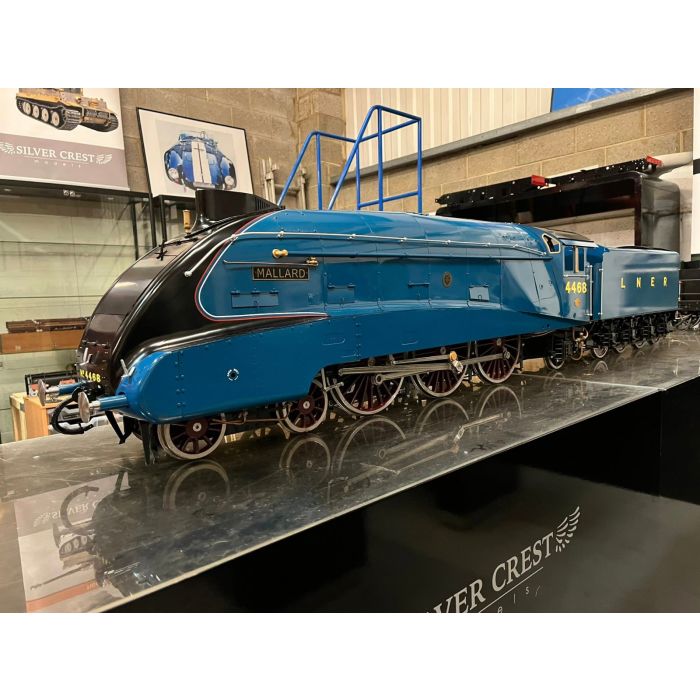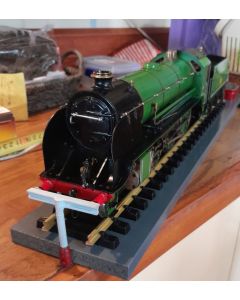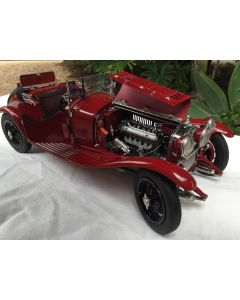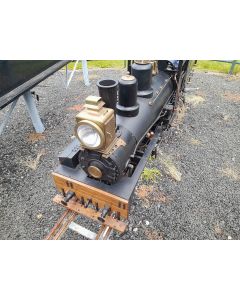5" Gauge LNER A4 Live Steam Locomotive
Half Of The Production Batch Is Already Pre-Sold!
We offer payment plans with only a deposit required to secure your place in the production run. We also deliver to your door, Australia wide.
This superb 5" gauge LNER A4 is back in production after strong demand, and half the batch is already pre-sold. Built directly from original works drawings, it captures the proportions, stance and iconic streamlining of the full-size locomotive with impressive accuracy.
Every major component has been engineered for reliable running, smooth steaming and long service life, not just display value. Fully painted, lined and supplied with your choice of livery, name and number, this is a serious miniature locomotive for enthusiasts who care about both authenticity and performance.
- Length approx. 75" (190 cm) including tender.
- Three-cylinder live steam with Gresley Holcroft conjugating gear.
- Coal-fired, silver-soldered copper boiler tested to twice working pressure.
- Bronze cylinders with stainless steel pistons and valves.
- Sprung axle boxes with needle roller bearings.
- Outside Walschaerts valve gear with wire-cut components.
- Multi-element superheater and working drain cocks.
- Boiler feed via axle pump, injector and hand pump.
- Etched brass streamlined casing.
- Fully painted, lined and ready to run.
There's still time to choose your livery
- Two-tone Silver/Grey (Silver Jubilee)
- LNER Apple Green
- LNER Garter Blue
- LNER Wartime Black
- BR Express Passenger Blue
- BR Lined Brunswick Green
Each locomotive is supported with a 12-month warranty and ongoing parts availability, ensuring confident running and long-term maintainability for years to come.
Payment plans available

5" Gauge LNER A4 Live Steam Locomotive Specs
This 5" gauge LNER A4 live steam locomotive is a serious piece of engineering designed for enthusiasts who care about accuracy, performance and presence on the track. Built to capture the powerful stance and flowing streamlined lines of the full size A4s, this model combines scale fidelity with robust, ready-to-run practicality. Fully painted, lined and finished to a high standard, it is equally at home hauling passengers on club tracks or taking pride of place in a serious collection.
Overview
Under the iconic streamlined casing you will find a coal fired, three cylinder live steam powerhouse with genuine miniature locomotive engineering throughout. From the silver soldered copper boiler to the stainless steel motion and finely machined valve gear, this is a locomotive built for smooth running, reliability and long service life.
- Length approximately 75" (around 190.5 cm)
- Coal fired live steam
- 3 cylinders with inside cylinder using Gresley Holcroft conjugating gear
- Silver soldered copper boiler
- Boiler feed by axle pump, injector and hand pump
- Bronze cylinders with stainless steel pistons and valves
Running Gear and Motion
The running chassis is designed for dependable performance on 5" gauge track with attention given to smooth riding, efficient steam use and low maintenance. Premium materials and modern machining techniques are used throughout the motion to deliver reliable operation and repeatable performance.
- Sprung axle boxes with needle roller bearings
- Outside Walschaerts valve gear
- Piston valves
- Stainless steel motion
- Multi element superheater
- Working drain cocks
- Reverser
Boiler, Bodywork and Construction
The boiler and bodywork are built to offer a balance of scale appearance, strength and ease of maintenance. The etched brass casing captures the complex curves of the A4 streamlining while the copper boiler and fittings are specified for reliable steaming and safety.
- Silver soldered copper boiler, hydraulically tested
- Etched brass streamlined casing
- Boiler feed by axle pump, injector and hand pump
- Safety valves fitted
Finish, Options and Presentation
Each locomotive is supplied fully finished, ready to steam and enjoy. With options for livery, name and number, you can specify a locomotive that matches your favourite A4 or your existing collection. The paintwork and lining are applied to a high standard so the model looks as impressive on display as it does at speed on the track.
- Choice of authentic liveries
- Choice of name and number
- Fully painted and lined
- Ready to run
Mallard Locomotive: The Record-Breaking Speed Icon
Mallard locomotive is world-famous for setting the steam locomotive speed record of 126 mph on July 3, 1938, a record that still stands today. The case mallard is notable not only for this record-breaking achievement but also for its technical significance and enduring place in railway history. This article explores Mallard’s remarkable journey from its creation, through wartime service, to its lasting legacy and influence in popular culture.
Key Takeaways
Mallard, designed by Sir Nigel Gresley in 1938, set the world speed record for steam locomotives at 126 mph, a benchmark that remains unbroken.
Mallard is recognized as the world's fastest steam locomotive, a title earned during its record-setting run in 1938.
The innovative design of Mallard included aerodynamic features and technical advancements, such as a double Kylchap chimney and a high boiler pressure of 250 psi, enhancing its speed and efficiency.
Mallard’s legacy endures through its preservation as a national treasure, its influence in popular culture, and its continued appeal to railway enthusiasts worldwide.
The Birth of Mallard
Mallard is part of the LNER Class A4 4-6-2 ‘Pacific’ locomotives, a series designed by the renowned engineer Sir Nigel Gresley. Built on the 3rd of March 1938, Mallard was the pinnacle of a vision to create a locomotive capable of unprecedented speeds on the long-distance express routes of the London and North Eastern Railway (LNER).
Mallard emerged from a demand for speed and efficiency in British transport. Crafted for high-speed travel over long distances, it showcased Gresley’s relentless innovation. Its streamlined trains design reduced air resistance, facilitating smoother, faster journeys.
Gresley’s fascination with ornithology influenced the naming of the A4 locomotives, with Mallard named after the swift and graceful wild bird. This added elegance and a unique identity, highlighting the blend of natural inspiration and technological prowess in Gresley’s work.
Other notable LNER locomotives of the A4 class include Silver Link, Silver King, Silver Fox, Golden Shuttle, and Sir Charles Newton. These iconic A4s, such as 2512 Silver Fox and 2511 Silver King, were renowned for their record-breaking runs and streamlined designs, each contributing to the legacy of the LNER locomotives and their place in British railway history.
Record-Breaking Run
The most celebrated chapter in Mallard’s history came on July 3, 1938. On this day, between Little Bytham and Essendine on the Stoke Bank, Mallard achieved the world speed record for steam locomotives, a steam speed record that still stands today. Reaching a top speed of 126 mph (203 kph), Mallard set a benchmark that has become a point of pride for railway enthusiasts worldwide.
Mallard’s record-breaking run occurred on an accelerated downhill stretch between Grantham and Peterborough, chosen for its perfect gradient. The train’s total weight and precise calculations were crucial to achieving the maximum speed.
Driver Joseph Duddington and fireman Thomas Bray were pivotal in this record attempt, taking calculated risks. Their expertise and bravery pushed Mallard to its limits, ensuring peak performance. The 126 mph record speed was a testament to human ingenuity and relentless pursuit of excellence, showcasing the skills of driver Duddington. Inspector Sid Jenkins was present during the record attempt to validate the observations and ensure safety, adding credibility to the achievement.
For context, George Henry Haygreen was the driver of the A4 locomotive Silver Fox during a notable high-speed trial in August 1936, where he reached 113 mph on Stoke Bank in a previous record attempt.
This record run transcended engineering, capturing public imagination and cementing Mallard’s historical significance. Celebrations like the Great Gathering, where surviving A4 locomotives were showcased, commemorate this remarkable event. The publicity department played a key role in promoting Mallard’s achievement, organizing press coverage and enhancing its public appeal.
Technical Specifications and Innovations
Mallard was not just about speed; it was a marvel of engineering and innovation. The locomotive’s design included:
A wind tunnel-tested aerodynamic shape, crucial for improving performance
A streamlined structure that reduced air resistance
Streamlined side skirts (side valances) fitted along the lower sides to further improve aerodynamics and reduce drag
The ability to cut through the air with minimal drag
A key innovation in Mallard’s design was the double Kylchap chimney, enhancing operational efficiency by improving smoke dispersal. This feature allowed better airflow and reduced back pressure, boosting overall performance.
Mallard’s maximum boiler pressure of 250 psi was another testament to its technical prowess, enabling greater power and speed. The inside cylinder and valve gear were engineered to handle these pressures, ensuring high speeds without compromising safety.
A dynamometer car used during the record run provided valuable data on Mallard’s performance, measuring speed, power, and other parameters. These insights refined future locomotive designs, blending art and science and cementing Mallard’s iconic status.
Wartime Service and Post-War Operations
The Second World War brought significant changes to Mallard’s appearance and operation:
The locomotive’s streamlined valances were removed to simplify maintenance and reduce visibility.
It was painted in black.
Mallard was renumbered to E22, blending into the wartime landscape while continuing to serve the nation.
During the war, chime whistles were removed from locomotives like Mallard to prevent confusion with air raid sirens, which were used to warn civilians of air raids.
Despite its triumphs, Mallard faced challenges:
Post-record run, it experienced mechanical issues, especially with the middle cylinder, necessitating a temporary withdrawal.
Modifications were needed throughout its operational life.
Multiple boiler replacements were required during its service.
After the war, Mallard returned to service, resuming its role under British Rail on non stop services across the country. Modifications and repairs ensured it remained a reliable workhorse, adapting to the railways’ changing needs in the post-war era.
Livery and Aesthetics
Mallard’s aesthetic journey is as captivating as its technical evolution. Initially painted in garter blue, this livery became iconic, symbolizing speed and elegance. It was more than just a color; it represented the locomotive’s advanced design and capabilities.
During the Second World War, Mallard’s appearance changed drastically. It was repainted in black to blend in and avoid detection, a stark contrast to its peacetime glory. This black livery was a practical choice, reflecting the somber realities of the war while ensuring the locomotive’s continued operation.
Post-war, Mallard was repainted in BR blue, marking its return under British Railways. Other A4 locomotives were also repainted in BR green, a standard British Rail livery after World War II. The BR green livery, with its distinctive lining and markings, became historically significant as it represented a new era for the locomotives and highlighted their continued prestige on the railways. In 1963, upon preservation, it was restored to its original garter blue livery. The various liveries throughout its life narrate a tale of resilience, adaptation, and a return to iconic status.
Preservation and Legacy
Mallard’s preservation journey has been as remarkable as its operational history. Following its withdrawal from active service, Mallard became a static exhibit at the National Railway Museum, allowing future generations to appreciate its historical significance. Other preserved A4s include Dominion of Canada and Dwight D Eisenhower, both of which have international significance due to their export and display abroad. It remains a central attraction for railway enthusiasts.
Preserving Mallard in pristine condition has necessitated significant overhauls, ensuring it remains in excellent condition for public display. Mallard and other A4s have been displayed in the Great Hall at the National Railway Museum, showcasing their importance in railway history. This dedication underscores Mallard’s status as a national treasure.
Events like the Great Gathering have underscored Mallard’s historical significance, bringing together four locomotives. These gatherings celebrate Mallard’s achievements and honor the legacy of all A4 locomotives in the union of south africa.
Major overhauls and obtaining a valid boiler certificate are necessary for mainline operation of preserved steam locomotives; when a boiler certificate expires, locomotives like Mallard are often placed on static display until restoration is possible.
Mallard’s legacy is more than just a machine; it represents a pinnacle of engineering, a symbol of human ingenuity, and an inspiring piece of history. Its story testifies to the enduring appeal of steam locomotives and their place in our collective memory.
Mallard in Popular Culture
Mallard’s influence extends into popular culture. The 1993 Blur album ‘Modern Life Is Rubbish’ features a painting of Mallard, symbolizing a nostalgic connection to pre-war Britain and underscoring its iconic status and cultural impact.
In the American TV series NCIS, a model of Mallard regularly appears in the autopsy department, belonging to Dr. Donald ‘Ducky’ Mallard. Additionally, a brick sculpture named the Brick Train, depicting Mallard, created by artist David Mach in 1997, is located near Darlington, County Durham. These cultural references showcase Mallard’s lasting impression on both sides of the Atlantic.
Comparison to Other Locomotives
The LNER Class A4 4468 “Mallard” stands apart in the world of steam locomotives, not only for its record-breaking run but also for the company it keeps among the giants of railway history. When discussing the world speed record for steam locomotives, Mallard is often compared to other legendary machines, such as the German DRG Class 05 No. 002 and the American Milwaukee Road class A locomotives.
The German locomotive DRG Class 05 briefly held the world steam speed record before Mallard’s historic achievement. However, Mallard’s record speed of 126 mph (203 kph), set on the Stoke Bank section of the East Coast Main Line, remains unbeaten to this day. The record was meticulously recorded using a dynamometer car, ensuring its place in the official record books and distinguishing it from other claims.
American contenders like the Milwaukee Road class A locomotives were renowned for their ability to haul trains at sustained high speeds, often exceeding 100 mph in regular service. Yet, their top speed never surpassed Mallard’s, and their record attempts lacked the same level of official verification. Similarly, the Pennsylvania Railroad’s Class T1 locomotives made bold claims of high-speed runs, but without dynamometer data, these feats remain unverified in the eyes of railway historians.
Within Britain, the Mallard is frequently compared to the iconic Flying Scotsman. While the Flying Scotsman was designed for long-distance express services and became famous for its non-stop runs between London King’s Cross and Edinburgh, its design was more traditional, featuring a two-cylinder engine and a larger boiler. In contrast, the LNER Class A4 locomotives, including Mallard, were purpose-built for high speed, with a streamlined body and a powerful three-cylinder engine that allowed them to reach unprecedented speeds. The Mallard’s record-breaking run on Stoke Bank was a testament to this focus on speed and innovation.
What truly sets Mallard apart is the official recognition of its world speed record for steam locomotives. The use of a dynamometer car during the record attempt provided irrefutable data, making Mallard’s achievement the only one recognized by Guinness World Records. This level of precision and documentation has ensured that Mallard’s record remains the gold standard for steam speed records.
Today, Mallard is preserved as a static display at the National Railway Museum in York, where it continues to captivate visitors from around the world. Its status as the world’s fastest steam locomotive, combined with its elegant design and storied history, makes it a symbol of British engineering excellence and a lasting inspiration for steam enthusiasts and engineers alike.
In summary, while many locomotives have vied for the title of the fastest steam locomotive, none have matched the combination of speed, official recognition, and enduring legacy that defines Mallard. Its world speed record, set on the East Coast Main Line and recorded for posterity, remains a crowning achievement in the history of steam locomotives.
Why we chose the Mallard For Live Steam
Choosing Mallard for live steam models was driven by its iconic status and immense popularity among enthusiasts. Its record as the world’s fastest steam locomotive adds to its allure, making it a favorite among steam locomotive aficionados and express locomotives.
Mallard’s design and features make it ideal for live steam models. Its double chimney and high boiler pressure are technical marvels that captivate enthusiasts. Replicating these features offers a unique and thrilling experience for hobbyists.
Our head engineer, Mike Pavie of Silver Crest Models, and strong client demand were pivotal in selecting Mallard for live steam. Its blend of historical significance and technical excellence ensures that the legacy of this remarkable locomotive continues to inspire future generations.
Summary
In summary, the Mallard locomotive stands as a remarkable feat of engineering and a symbol of human achievement. From its birth and design under Sir Nigel Gresley to its record-breaking run and subsequent wartime and post-war service, Mallard’s story is one of innovation, resilience, and enduring legacy. Its various liveries, preservation efforts, and influence on popular culture further cement its place in history.
Reflecting on Mallard’s journey, it is clear that this locomotive is more than just a machine; it is a testament to the ingenuity and ambition of its creators. As we continue to celebrate Mallard’s legacy, we are reminded of the timeless appeal of steam locomotives and their significant impact on our collective history.
Frequently Asked Questions
What is the world speed record set by Mallard?
Mallard holds the world speed record for steam locomotives at 126 mph (203 kph), achieved on July 3, 1938. This record remains a significant achievement in railway history.
Why was Mallard painted black during the Second World War?
Mallard was painted black during the Second World War to simplify maintenance and minimize visibility. This strategic decision aided in operational effectiveness during the conflict.
What is the significance of the double Kylchap chimney in Mallard's design?
The double Kylchap chimney is significant in Mallard's design as it enhances smoke dispersal and improves operational efficiency, thereby elevating the locomotive's overall performance.
Where can Mallard be seen today?
Mallard can be seen today as a static exhibit at the National Railway Museum, where it is preserved for public display.
Why is Mallard popular among live steam enthusiasts?
Mallard is favored among live steam enthusiasts because it is renowned as the world's fastest steam locomotive and showcases impressive engineering, inspiring models that capture its technical achievements.
Buy from a trusted Australian seller

Fastest Delivery
Fast delivery anywhere in the World with local stock dispatched same day!

Outstanding Quality
All of our trains are produced to a high quality standard and include warranty.

Australian Seller
Real Aussie enthusiests selling premium quality products.









